Creating a compelling story outline is a crucial step in the writing process, whether you are drafting a novel, screenplay, or short story. A well-crafted outline helps organize your thoughts, ensures a cohesive plot, and keeps you on track as you write. This guide will cover the basics of a story outline, the benefits of creating one online, various story outline templates, and step-by-step instructions on how to write an effective story outline.
What is a Story Outline?
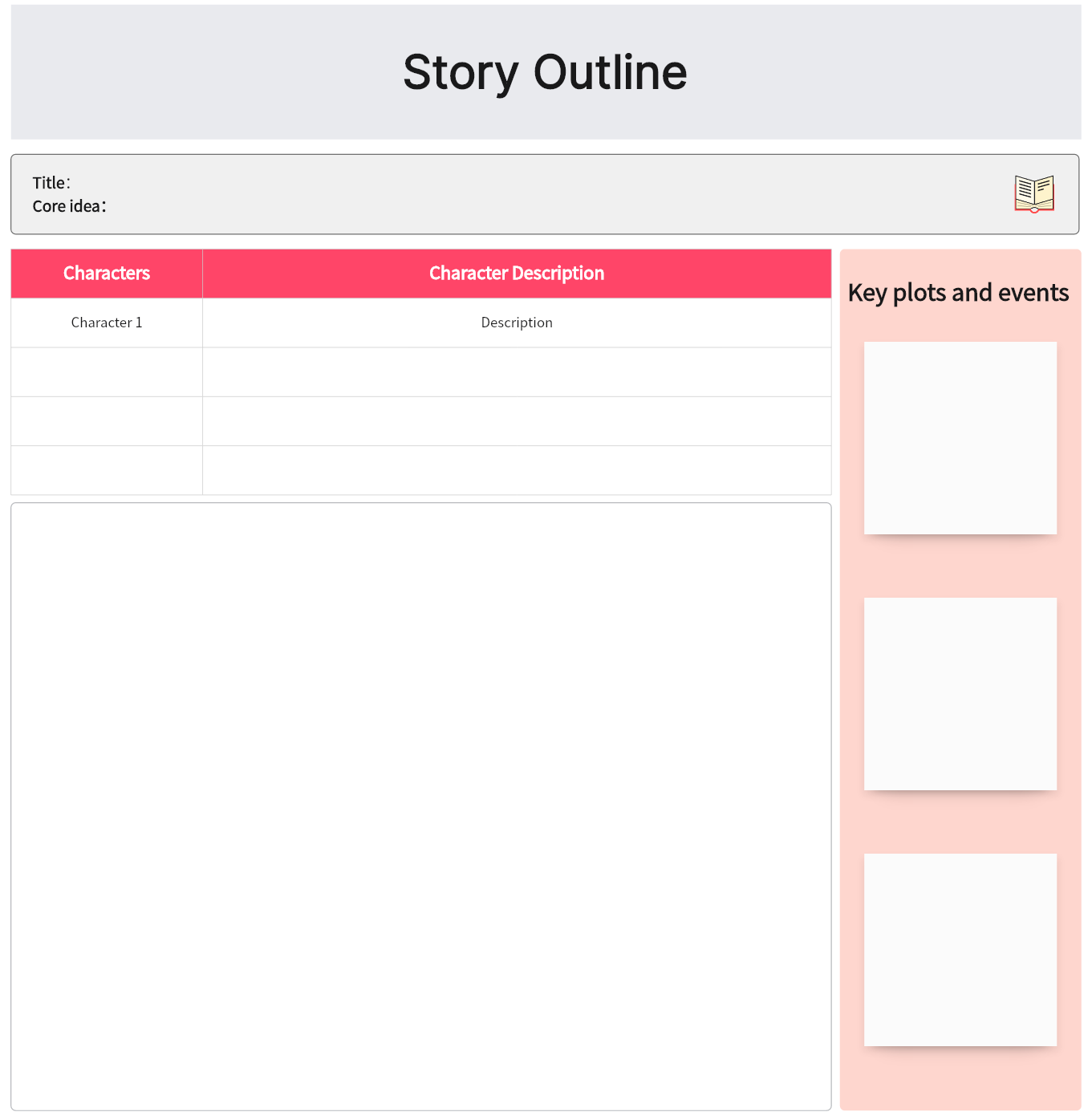
A story outline is a structured plan that details the sequence of events in your narrative. It includes major plot points, character arcs, and key scenes, providing a roadmap for your writing. Outlines vary in complexity, from simple bullet points to detailed scene-by-scene breakdowns.
The main components of a story outline typically include:
Introduction: Establishes the setting, characters, and initial conflict.
Rising Action: Builds tension through a series of events leading up to the climax.
Climax: The turning point or most intense moment in the story.
Falling Action: Events that follow the climax, leading towards the resolution.
Resolution: The conclusion of the story, where conflicts are resolved, and characters' arcs are completed.
Why Should You Create Story Outline Online?
While traditional methods of outlining with pen and paper or offline software have their merits, creating a story outline example online offers distinct advantages that can enhance productivity and creativity.
1. Accessibility and Convenience
Online story outlining tools are accessible from any device with an internet connection. This means you can work on your outline from your computer, tablet, or smartphone, whether you are at home, at a café, or on the go. Boardmix allows you to save your outlines in the cloud, ensuring that your work is always backed up and available whenever you need it.
2. Real-Time Collaboration
Writing is often a collaborative process, involving input and feedback from co-writers, editors, or mentors. Online tools facilitate real-time collaboration, allowing multiple users to view, edit, and comment on the outline simultaneously. Boardmix supports real-time collaboration, enabling you to share your outline with others easily. Collaborators can provide instant feedback, make suggestions, and contribute to the development of the story. T
3. Enhanced Organization
Online outlining tools offer advanced organizational features that can help you keep your work structured and easily navigable. These tools often include drag-and-drop functionality, color coding, and tagging, which can streamline the outlining process. Boardmix provides a user-friendly interface with customizable templates and organizational tools. You can color-code sections, tag important plot points, and use character profiles to rearrange scenes or chapters effortlessly.
4. Flexibility and Adaptability
One of the main advantages of creating a story outline example online is the ease with which you can update and modify your outline. As your story develops, you may need to make significant changes to the plot, characters, or structure. Online tools make this process quick and painless.
Boardmix offers flexible editing options that allow you to revise your outline as needed. You can easily add or remove sections, update character profiles, and modify plot points.
5. Visualization Tools
Visualization tools can help you see the bigger picture of your story, making it easier to identify plot holes, character arcs, and thematic elements. Boardmix includes a variety of visualization tools, such as storyboards, that help you visualize the structure of your story. These tools provide a clear overview of how different elements of your story connect and interact, making it easier to identify and address any inconsistencies or gaps in the plot.
Story Outline Templates
Using a story outline template can significantly streamline the writing process by providing a clear structure for your narrative. Templates help ensure that all essential elements of a story are included and well-organized. Here are some detailed story outline templates that can cater to different types of stories and writers' needs, and you can find these templates in Boardmix.
1. The Three-Act Structure Story Outline
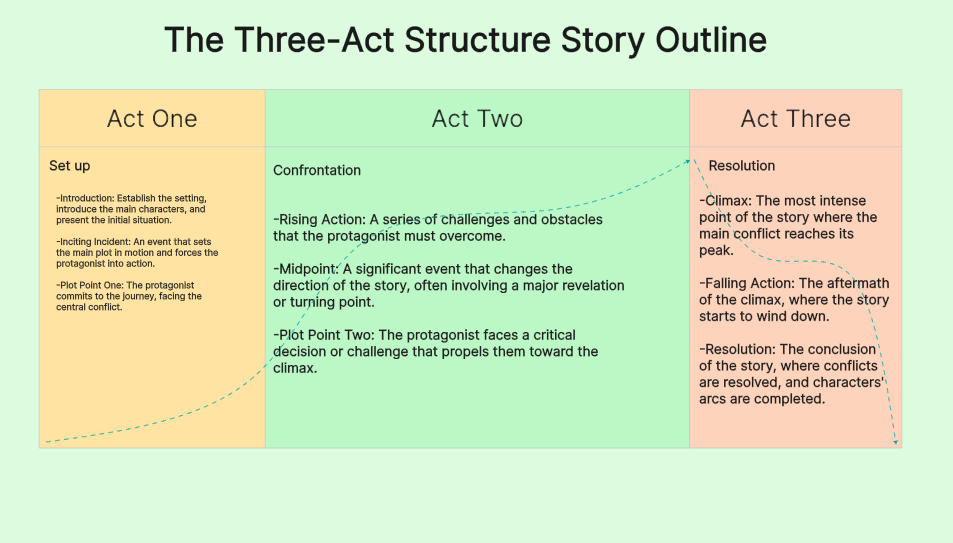
The Three-Act Structure is one of the most popular templates for outlining stories, particularly in screenwriting and novel writing. It divides the story into three main sections: Setup, Confrontation, and Resolution.
Act One: Setup
-Introduction: Establish the setting, introduce the main characters, and present the initial situation.
-Inciting Incident: An event that sets the main plot in motion and forces the protagonist into action.
-Plot Point One: The protagonist commits to the journey, facing the central conflict.
Act Two: Confrontation
-Rising Action: A series of challenges and obstacles that the protagonist must overcome.
-Midpoint: A significant event that changes the direction of the story, often involving a major revelation or turning point.
-Plot Point Two: The protagonist faces a critical decision or challenge that propels them toward the climax.
Act Three: Resolution
-Climax: The most intense point of the story where the main conflict reaches its peak.
-Falling Action: The aftermath of the climax, where the story starts to wind down.
-Resolution: The conclusion of the story, where conflicts are resolved, and characters' arcs are completed.
2. The Hero’s Journey Story Outline
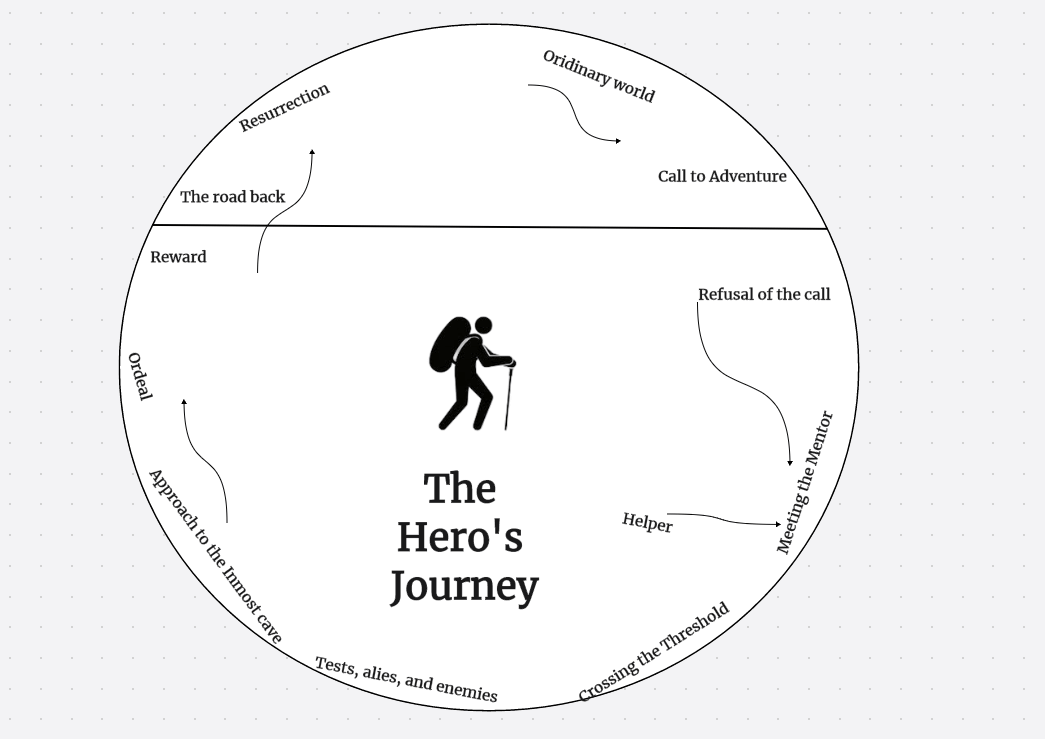
The Hero’s Journey, also known as the Monomyth, is a narrative template identified by Joseph Campbell. It outlines the typical adventure of the archetypal hero and is divided into twelve stages.
Ordinary World: The hero’s normal life before the adventure begins.
Call to Adventure: The hero is presented with a challenge or quest.
Refusal of the Call: The hero initially refuses the adventure.
Meeting the Mentor: The hero meets a mentor who provides guidance.
Crossing the Threshold: The hero commits to the adventure, leaving the ordinary world.
Tests, Allies, and Enemies: The hero faces challenges and makes allies and enemies.
Approach to the Inmost Cave: The hero prepares for a significant challenge.
Ordeal: The hero faces a major challenge or crisis.
Reward: The hero earns a reward after overcoming the ordeal.
The Road Back: The hero begins the return journey.
Resurrection: The hero faces a final test or challenge.
Return with the Elixir: The hero returns home transformed, with new knowledge or power.
3. Snowflake Method Story Outline
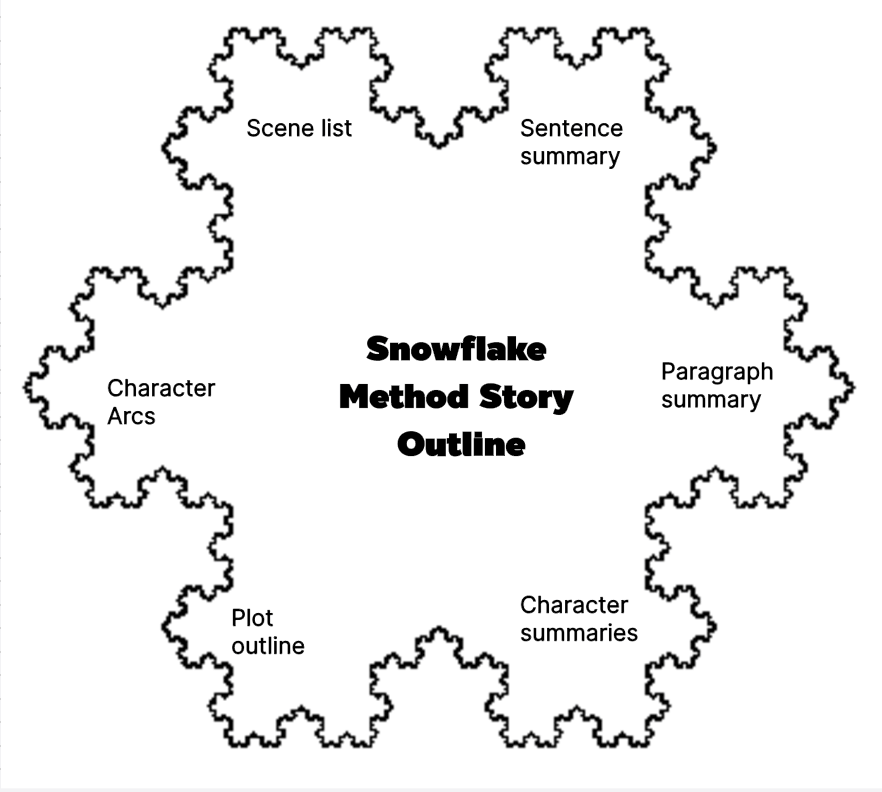
The Snowflake Method is a systematic approach to outlining a story, developed by Randy Ingermanson. It starts with a simple idea and gradually builds it into a complex narrative.
One-Sentence Summary: Condense the story into a single sentence.
One-Paragraph Summary: Expand the sentence into a paragraph outlining the main conflict and resolution.
Character Summaries: Write a one-page summary for each major character, detailing their goals, motivations, and conflicts.
Expanded Plot Outline: Expand the one-paragraph summary into a page-long outline, covering key plot points.
Character Arcs: Develop detailed arcs for each character, showing how they change throughout the story.
Scene List: Create a list of scenes, detailing what happens in each and how they advance the plot.
Scene Summaries: Write a summary of each scene, including the setting, characters, and main actions.
4. Beat Sheet Story Outline
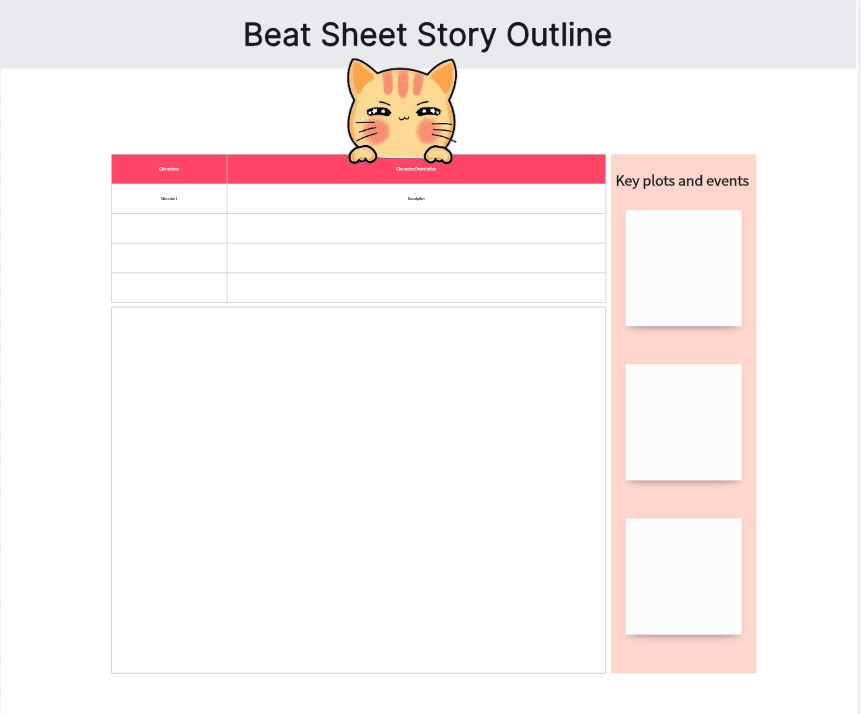
The Beat Sheet is a popular template used primarily in screenwriting. It breaks down the story into “beats” or key moments that drive the narrative forward.
Opening Image: The first impression of the story, setting the tone and mood.
Theme Stated: The central theme or moral of the story is hinted at.
Setup: Introduction of main characters and the world they inhabit.
Catalyst: An event that disrupts the status quo and sets the story in motion.
Debate: The protagonist grapples with the challenge and considers different options.
Break into Two: The protagonist commits to the main journey or challenge.
B Story: Introduction of a secondary plotline that complements the main story.
Fun and Games: The core of the story, where the premise is explored in depth.
Midpoint: A significant turning point that changes the direction of the story.
Bad Guys Close In: Rising tension as antagonistic forces grow stronger.
All Is Lost: The protagonist hits rock bottom, facing their greatest challenge.
Break into Three: A new idea or plan that leads to the climax.
Finale: The climax and resolution, where the main conflict is resolved.
Final Image: The closing scene, reflects how the protagonist has changed.
5. Scene-by-Scene Story Outline
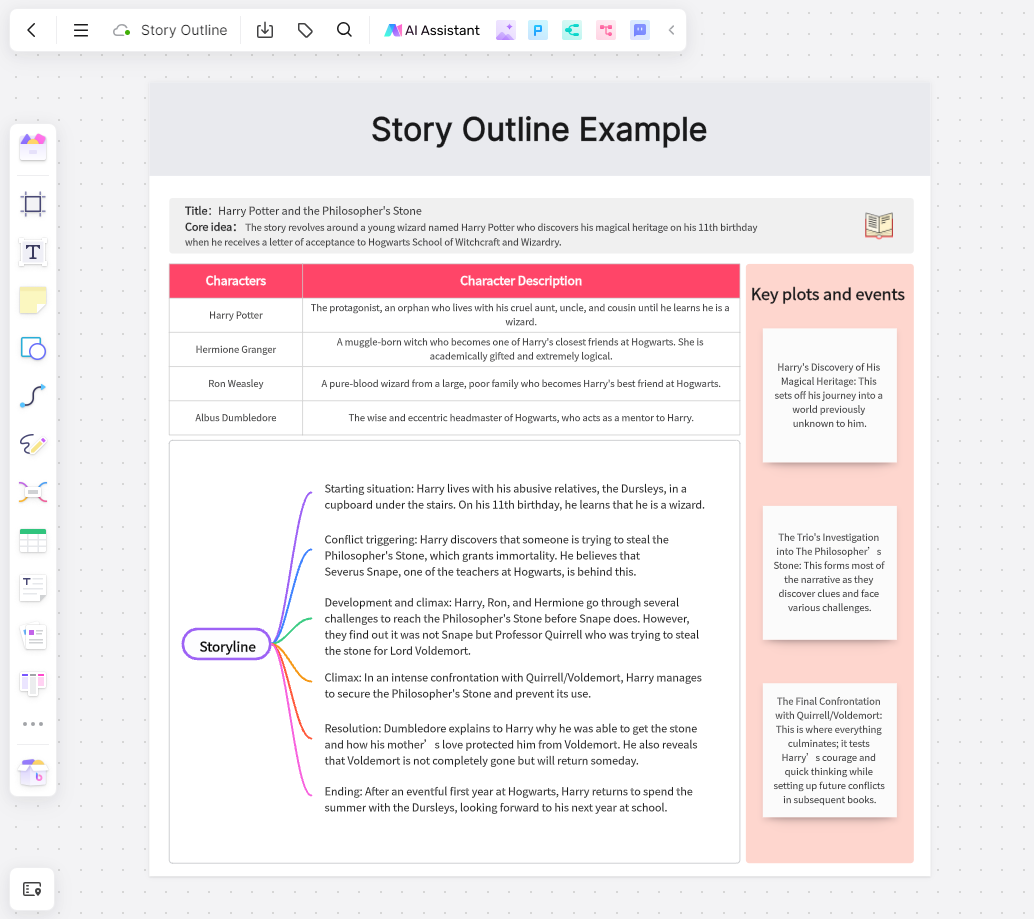
A Scene-by-Scene Outline provides a detailed breakdown of every scene in the story, focusing on specific elements to ensure a cohesive narrative.
Scene Number: Number each scene for easy reference.
Setting: Describe where the scene takes place.
Characters: List the characters involved in the scene.
Purpose: Explain the scene’s role in advancing the plot or developing characters.
Action: Detail the key events and actions that occur in the scene.
Dialogue: Include important lines or exchanges that drive the narrative.
Transition: Note how the scene transitions to the next, ensuring smooth progression.
By choosing the template that best suits your story and writing style, you can create a compelling and cohesive outline that serves as a strong foundation for your narrative.
How to Write Story Outline?
Creating a story outline template provides a structured approach to developing your narrative, ensuring all essential elements are included and well-organized.
1. Start with a Concept
Begin with a clear idea of your story’s premise. What is the central conflict? Who are the main characters? What themes do you want to explore? When you make sure the main concept, you can choose a suitable template to write the story online.
2. Define the Main Plot Points
Identify the key events in your story. These include the inciting incident, major turning points, climax, and resolution. Sketch these out to form the backbone of your outline.
3. Develop Your Characters
Create detailed profiles for your main characters. Understand their goals, motivations, conflicts, and growth throughout the story. How do they change from the beginning to the end?
4. Structure Your Outline
Choose a template that suits your story and start filling it in. Begin with broad strokes and then add more detail. Ensure each act, beat, or scene advances the plot and develops the characters.
5. Detail the Scenes
Break down your story into individual scenes. For each scene, note the setting, characters involved, the main action, and how it moves the plot forward. Consider how each scene transitions to the next.
6. Incorporate Subplots
Weave in subplots that complement and enhance the main plot. Subplots can provide depth to your characters and add complexity to the story.
7. Utilize Online Tools like Boardmix
Using an online tool like Boardmix can streamline the outlining process. Boardmix offers features like customizable templates, drag-and-drop organization, real-time collaboration, and easy access from multiple devices. These tools can help you visualize your story outline, make quick adjustments, and receive feedback from collaborators.
Creating a compelling story outline is an essential step for any writer. It provides a structured approach to developing your narrative, ensuring that your plot is coherent and your characters are well-developed. Utilizing templates can simplify the process, and online tools like Boardmix offer additional benefits like accessibility, collaboration, and organization. By following these steps and using the right tools, you can create a detailed and effective story outline that will guide you through the writing process and help you craft a captivating story.









